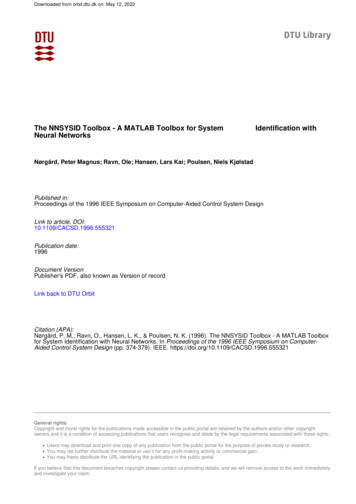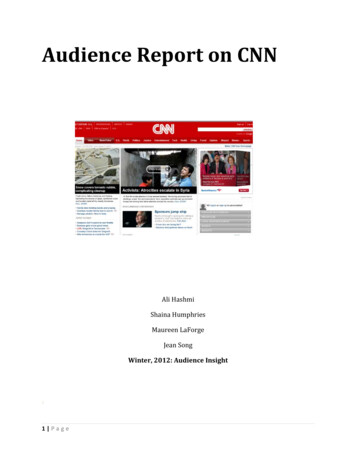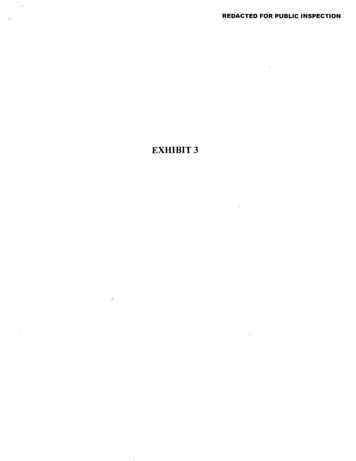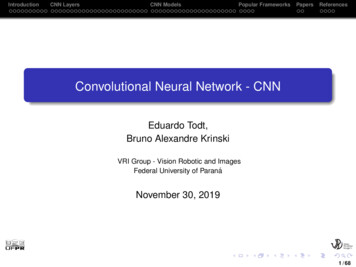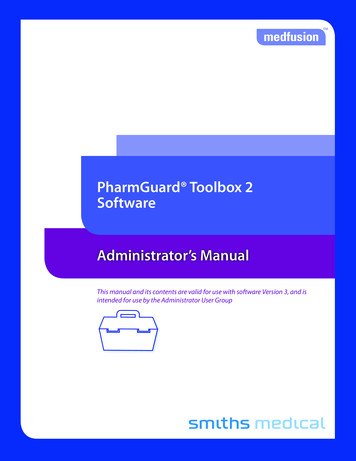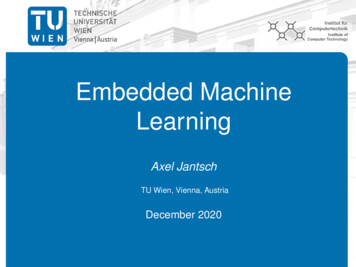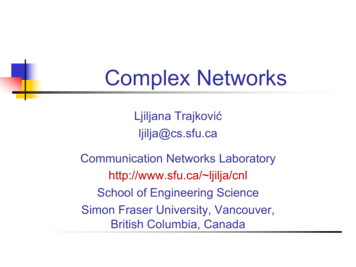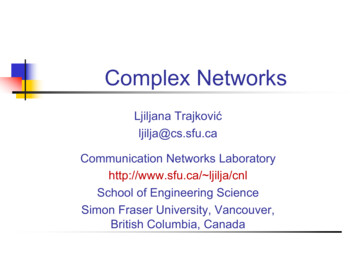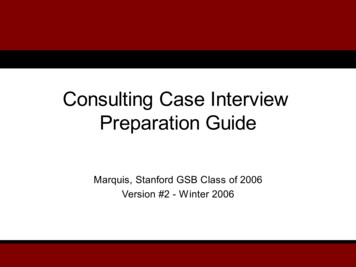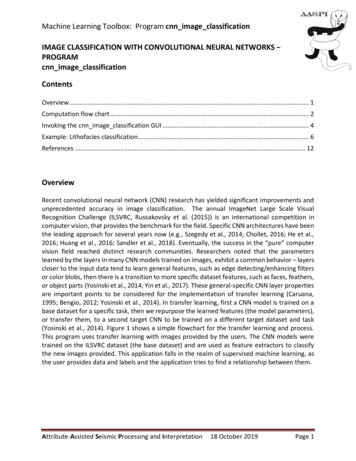
Transcription
Machine Learning Toolbox: Program cnn image classificationIMAGE CLASSIFICATION WITH CONVOLUTIONAL NEURAL NETWORKS PROGRAMcnn image classificationContentsOverview . 1Computation flow chart . 2Invoking the cnn image classification GUI . 4Example: Lithofacies classification. 6References . 12OverviewRecent convolutional neural network (CNN) research has yielded significant improvements andunprecedented accuracy in image classification. The annual ImageNet Large Scale VisualRecognition Challenge (ILSVRC, Russakovsky et al. (2015)) is an international competition incomputer vision, that provides the benchmark for the field. Specific CNN architectures have beenthe leading approach for several years now (e.g., Szegedy et al., 2014; Chollet, 2016; He et al.,2016; Huang et al., 2016; Sandler et al., 2018). Eventually, the success in the “pure” computervision field reached distinct research communities. Researchers noted that the parameterslearned by the layers in many CNN models trained on images, exhibit a common behavior – layerscloser to the input data tend to learn general features, such as edge detecting/enhancing filtersor color blobs, then there is a transition to more specific dataset features, such as faces, feathers,or object parts (Yosinski et al., 2014; Yin et al., 2017). These general-specific CNN layer propertiesare important points to be considered for the implementation of transfer learning (Caruana,1995; Bengio, 2012; Yosinski et al., 2014). In transfer learning, first a CNN model is trained on abase dataset for a specific task, then we repurpose the learned features (the model parameters),or transfer them, to a second target CNN to be trained on a different target dataset and task(Yosinski et al., 2014). Figure 1 shows a simple flowchart for the transfer learning and process.This program uses transfer learning with images provided by the users. The CNN models weretrained on the ILSVRC dataset (the base dataset) and are used as feature extractors to classifythe new images provided. This application falls in the realm of supervised machine learning, asthe user provides data and labels and the application tries to find a relationship between them.Attribute-Assisted Seismic Processing and Interpretation18 October 2019Page 1
Machine Learning Toolbox: Program cnn image classificationFigure 1. Visual representation of the transfer learning process. We generically representconvolutional and pooling layers with gray and golden rectangles whereas green circles representdensely connected neurons, commonly used as classification layers. Base task (a.) in this caserepresents an image from the ILSVRC going through a generic CNN model (convolutional layersand classification layers) trained on the same dataset. The CNN model then outputs theprobability of the image belonging to one of the thousands of classes of the ILSVRC. For thetransfer learning process, we copy the parameters learned by the convolutional layers on thebase task using the blue rectangle as a feature extractor, in this example, a pseudo-RGB seismicimage. We then train a new classification layer based on the extracted features. The finalclassification (amount of CO2 leaked) depends on the secondary task.Computation flow chartTo execute the transfer learning process using cnn image classfication, the user needs toprovide a root folder containing examples of each one of the classes to be classified in subfolders(Figure 2). We suggest at least 100 examples (pictures) for each one of the classes. The flow charton the following page shows an overview of the complete process.Attribute-Assisted Seismic Processing and Interpretation18 October 2019Page 2
Machine Learning Toolbox: Program cnn image classificationFigure 2. Cartoon showing how the data should be stored for cnn image classification. Eachtarget class requires its own subfolder containing the corresponding class “examples”. Werecommend providing at least 100 examples for each class.Root folderSplit the dataTrainingValidationTestExtract featuresbottlenecksTraining (run ribute-Assisted Seismic Processing and Interpretation18 October 2019Page 3
Machine Learning Toolbox: Program cnn image classificationInvoking the cnn image classification GUIThe cnn image classification GUI is under the aaspi util Machine Learning Toolbox tab.(Figure 3). The program is divided in three tabs: Split Data, Transfer Learning, Test Model. Theuser needs to specify the root input folder containing subfolders (different classes). Each one ofthe subfolders should have “examples” of the classes where the examples are provided as in jpg, gif-, or png-format image files. The program can be used to split the data into training, validation,and test sets (Figure 4). After the data is split, the user computes the bottlenecks (extract thefeatures) and run transfer learning (Figure 5). The last step is to evaluate the classificationperformed (Figure 6).Figure 3. The cnn image classification GUI is under the aaspi util Machine Learning Toolboxtab.Figure 4. cnn image classification program Split Data tab. Browse to select the root input folder(containing subfolders with classes to be classified), select the percentage of data to be separatedfor validation and for test. Press “Run” to split the data with the chosen parameters.Attribute-Assisted Seismic Processing and Interpretation18 October 2019Page 4
Machine Learning Toolbox: Program cnn image classificationFigure 5. Transfer Learning tab: Specify the training and validation data folders. Select one CNNmodel from the list. Enter a name for the bottleneck to be created. Click “Run” and the programextracts the features from the selected data using the specified CNN model. Next, choose a modelname, select the number of epochs (iterations), select one of the optimizers available, and Runtransfer learning. Important note: when “Run transfer learning – Run” button is clicked, thebottlenecks created on the previous step (the name written in the “Enter bottlenecks’ name”box) and the used model (“Choose one CNN model”) are used to assemble the final retrainedmodel. Therefore, be careful to not create bottlenecks with “model A” and run transfer learningwith “model B” (results could still be reasonable with such mistake).Attribute-Assisted Seismic Processing and Interpretation18 October 2019Page 5
Machine Learning Toolbox: Program cnn image classificationFigure 6. On the final stage, the user can evaluate the retrained model. Select the trained model.The user can then: select a single image to be classified or select a whole folder (with the samestructure as before -root and subfolders) to be classified. When selecting a single image to beclassified, the program opens a window with the resulting classification. When a folder isclassified, a csv file is saved with resulting values.Example: Lithofacies classificationFor this tutorial, we selected a few images from Pires de Lima et. al (2019) to show how to usethe program. The dataset is composed of four classes (four different lithofacies). The followingimage shows a simple visualization of part of the dataset. Each one of the classes contains at least40 examples (images).Attribute-Assisted Seismic Processing and Interpretation18 October 2019Page 6
Machine Learning Toolbox: Program cnn image classificationAttribute-Assisted Seismic Processing and Interpretation18 October 2019Page 7
Machine Learning Toolbox: Program cnn image classificationAfter splitting the data (Split Data tab), three new folders are added at the same location as theroot folder:I then select the Transfer Learning tab and complete it with the newly created train andvalidation folders created. I also select MobileNetV2, enter the name for the bottlenecks:When I click “Create bottlenecks: Run” the program outputs information about its execution:Attribute-Assisted Seismic Processing and Interpretation18 October 2019Page 8
Machine Learning Toolbox: Program cnn image classificationWith the bottlenecks created, I choose a model name, select the number of epochs, an optimizer,and “Run transfer learning – Run”. The program outputs information about its execution again:Attribute-Assisted Seismic Processing and Interpretation18 October 2019Page 9
Machine Learning Toolbox: Program cnn image classificationAfter training, the program outputs the results in a graph:Because this is a very easy dataset for the CNN, the results are perfect. Train and validation scoresoverlap each other (indicating that there’s no over fitting), accuracy is 1.0 (all examples wereclassified according to the provided classes) and loss is very low (0.0 loss indicates “perfect”results).With the new model trained, I can evaluate its results on the test set (when the program runs, afolder is created under runs/models, models are saved in that folder):Attribute-Assisted Seismic Processing and Interpretation18 October 2019Page 10
Machine Learning Toolbox: Program cnn image classificationI then select a single image from the test set and the program outputs the results:Attribute-Assisted Seismic Processing and Interpretation18 October 2019Page 11
Machine Learning Toolbox: Program cnn image classificationWhen I select the test folder under “Select folder to be classified”, and “Classify the selectedfolder: Run”, the program saves a csv file in the test folder location:The csv file contains the probability assigned for each one of the classes for each one of the filesfound in the test folder, as well as the file name.This transfer learning approach was used in Pires de Lima et al. (2019a, 2019b, 2019c and2019d).ReferencesCaruana, R., 1995, Learning Many Related Tasks at the Same Time with Backpropagation, in G.Tesauro, D. S. Touretzky, and T. K. Leen, eds., Advances in Neural Information ProcessingSystems 7: MIT Press, 657–664.Chollet, F., 2016, Xception: Deep Learning with Depthwise Separable Convolutions: CoRR,abs/1610.0.He, K., X. Zhang, S. Ren, and J. Sun, 2016, Deep Residual Learning for Image Recognition, in 2016IEEE Conference on Computer Vision and Pattern Recognition (CVPR): IEEE, 770–778,doi:10.1109/CVPR.2016.90.Huang, G., Y. Sun, Z. Liu, D. Sedra, and K. Weinberger, 2016, Deep Networks with StochasticDepth.Attribute-Assisted Seismic Processing and Interpretation18 October 2019Page 12
Machine Learning Toolbox: Program cnn image classificationRussakovsky, O., J. Deng, H. Su, J. Krause, S. Satheesh, S. Ma, Z. Huang, A. Karpathy, A. Khosla, M.Bernstein, A. C. Berg, and L. Fei-Fei, 2015, ImageNet Large Scale Visual RecognitionChallenge: International Journal of Computer Vision, 115, 211–252, doi:10.1007/s11263015-0816-y.Sandler, M., A. Howard, M. Zhu, A. Zhmoginov, and L.-C. Chen, 2018, MobileNetV2: InvertedResiduals and Linear Bottlenecks: ArXiv e-prints.Szegedy, C., W. Liu, Y. Jia, P. Sermanet, S. E. Reed, D. Anguelov, D. Erhan, V. Vanhoucke, and A.Rabinovich, 2014, Going Deeper with Convolutions: CoRR, abs/1409.4.Yin, X., W. Chen, X. Wu, and H. Yue, 2017, Fine-tuning and visualization of convolutional neuralnetworks, in 2017 12th IEEE Conference on Industrial Electronics and Applications (ICIEA):IEEE, 1310–1315, doi:10.1109/ICIEA.2017.8283041.Yosinski, J., J. Clune, Y. Bengio, and H. Lipson, 2014, How transferable are features in deep neuralnetworks? Advances in Neural Information Processing Systems, 27, 3320–3328.(Ahead of print/In review/Submitted)Pires de Lima, R. A., F. Suriamin, K. J. Marfurt, and M. J. Pranter, 2019a, Convolutional neuralnetworks as an aid in core lithofacies classification: Interpretation, accepted, ahead ofprint.Pires de Lima, R. A., K. J. Marfurt, D. Duarte Coronado, and A. Bonar, 2019b, Progress andchallenges in deep learning analysis of geoscience images: in EAGE Annual MeetingExpanded Abstracts (accepted).Pires de Lima, R. A., A. Bonar, D. Duarte Coronado, K. J. Marfurt, and C. Nicholson, 2019c, Deepconvolutional neural networks as a geological image classification tool (in review).Pires de Lima, R. A., Y. Lin, K. J. Marfurt, 2019d, Transforming seismic data into pseudo-RGBimages to predict CO2 leakage using pre-learned convolutional neural networks weights:in SEG Expanded Abstract (submitted).Attribute-Assisted Seismic Processing and Interpretation18 October 2019Page 13
Recent convolutional neural network (CNN) research has yielded significant improvements and unprecedented accuracy in image classification. The annual ImageNet Large Scale Visual Recognition Challenge (ILSVRC, Russakovsky et al. (2015)) is an international competition in co
